Author: Zoey Date: 2022.8.5
A blood test is one of the most commonly used clinical tests, which can reflect various functions and abnormal changes of the body and provide a reference for judging the progress of the patient's condition as well as treating the disease. Each step of blood drawing can affect the quality of the specimen, thus affecting the accuracy of laboratory results and even leading to delayed diagnosis and reduced quality of care. The sequence of blood drawings is an important factor affecting the test results. The following is the blood drawing sequence and reasons of different color blood collection tubes.
a) Blood culture;
b) Coagulation tube (tubes with citrate additives);
c) Serum tubes (with or without clot activator, with or without gel);
d) Heparin tube (with or without gel plasma separator);
e) EDTA tubes (with or without gel);
f) Glycolytic inhibitor tubes;
g) All other tubes in no particular order unless otherwise directed.

1) Blood collected in bottles or tubes used for blood cultures may be contaminated with bacteria from non-sterile tube stoppers or shields. As a result, bacteria may proliferate and mislead a physician into believing that his or her patient has a blood infection. Therefore, blood culture bottles are collected first before any other tubes.
2) Test results can be sped up by using clot activators, which can interfere with coagulation tests like prothrombin (PT) and activated partial thromboplastin time (APTT). Therefore, a blue coagulation blood test tube is collected followed by the blood culture.
3) To prevent the possibility of PCR reactions being inhibited by heparin contamination, blood collection tubes for molecular assays should be collected before heparin anticoagulated blood collection tubes.
4) Due to its high potassium content, EDTA has the potential to inadvertently inflate a patient's potassium test results. As a result, EDTA-containing tubes must be collected after potassium-testing tubes.
5) On a white blood cell (WBC) differential test, the additives in gray stopper/shield tubes alter the microscopic appearance of blood cells. EDTA tubes are therefore gathered before glycolytic inhibitor tubes.
6) Blood collection tubes used for trace element testing should be collected separately if necessary, regardless of whether the additives in the pre-collection tubes contain the trace elements being evaluated; syringes should not be used for blood drawing.
7) During the drawing of blood specimens, the controversy over the sequence of blood collection tubes lies mainly in hemagglutination. The reason for this is that the puncture process causes damage to the vascular endothelium and thus activates coagulation factors. The longer the blood drawing time, the more clotting factors are activated, resulting in a higher likelihood of false values for the hemagglutination results.
1) To ensure the proper blood drawing sequence and prevent additive cross-contamination across tubes, the collected blood samples must be accurately numbered. It is advised that this be determined using regional laboratory standards because color labeling methods and additives in the tubes may differ.
2) When utilizing a butterfly wing needle to collect just sodium citrate anticoagulated specimens, the initial blood collection tube should be discarded. The discarded blood collection tube is used to pre-fill the line of the blood collection kit, which does not need to be completely filled. The reason is that the coagulation blood collection tube test has certain requirements for the volume of blood specimens. If the first tube is a blood collection tube used for direct coagulation, the air in the hose will use up some of the negative pressure, which will cause underdrawing. The pseudo-prolongation of the APTT is the main issue this results in.

Butterfly needle blood drawing
3) In order to ensure the proper blood-to-additive ratio and lessen the likelihood of hemolysis, it is not advisable to remove the rubber plug from the vacuum blood collection tube or apply pressure to the syringe needle bolt. And it is advisable to let the blood flow into the blood collection tube on its own until the blood flow stops.
[1]http://www.weivd.com/article-4393-1.html
[2]https://wenku.baidu.com/view/46aabba03e1ec5da50e2524de518964bce84d2c6.html
[3]https://www.phlebotomyexaminer.com/new-draw/
Gongdong Medical is an experienced high-end OEM medical blood tube factory, supplier, and manufacturer in China. Welcome to contact.